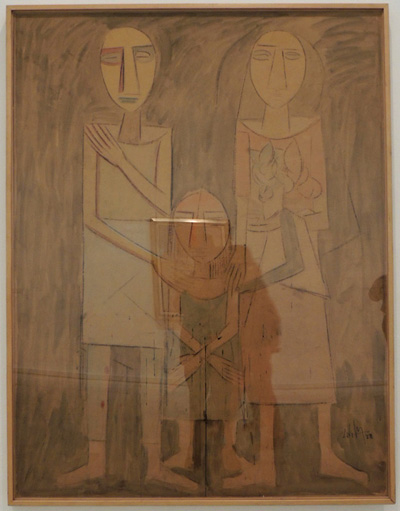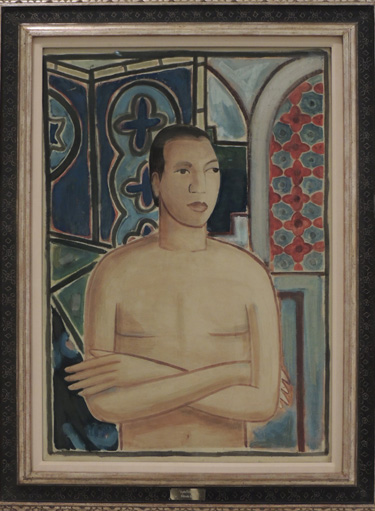Source: WTL photograph© of two paintings in the Wilfredo Lam exhibition at the Museo Nacional Centro de Arte Reina Sofía in Madrid (2016).
Images:Right: "Autorretrato, II [Self-Portrait, II]" (c. 1938: tempera on paper mounted on canvas; in the Rudman Trust collection). Left: "La Familia, I" (later, 1938: watercolor glued on canvas; private collection in Paris).
Comments: These two paintings show a personal, intimate, psychological/emotional side to the artist. In early 1937 his wife Eva Píriz and their young son both died of tuberculosis. From the exhibition's pamphlet about this painting on the left: "[It] reflects a severe schematization of the faces that have become monochromatic ovals. An expressionist language he is using to communicate the idea of masks, of identify in conflict and a fractured psyche." During the first phase of the Spanish Civil War (1936-1939) Lam used his talents to fashion Republican posters and propaganda, but the Republic soon began losing the Spanish Civil War to the fascist Nationalists of Gen. Franco. In late 1937 he was wounded in the fighting in Madrid, and at the end of the year he was sent to Barcelona, where he met Helena Holzer, a German researcher, whom he would marry later. In 1938, he moved to Paris, where he was supported enthusiastically by Pablo Picasso and where he met other modern artists such as Fernand Léger, Henri Matisse, Georges Braque, and Joan Miró. In the painting on the right he shows himself in a representational painting, recovered and once againa a confident 30+-year-old mulatto, alone, and, in a sense, naked to the world and himself.
Here's a photo of Wilfredo Lam with Pablo Picasso in 1954:
The paintings above clearly show, I think, Lam's affinity with those artists. Most especially we see the influence of Picasso's later Cubist work featuring stylized figures in the painting on the left. In addition, however, Lam shows in this work an emotional/artistic return to his own strong Afro-Cuban culture and identity.
Humanities Question: Describe the compositional elements in both paintings; compare and contrast them in the light of the information presented in the comments above.



